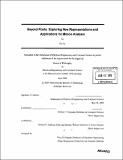Beyond pixels : exploring new representations and applications for motion analysis
Author(s)
Liu, Ce, Ph. D. Massachusetts Institute of Technology
DownloadFull printable version (26.78Mb)
Alternative title
Exploring new representations and applications for motion analysis
Other Contributors
Massachusetts Institute of Technology. Dept. of Electrical Engineering and Computer Science.
Advisor
William T. Freeman and Edward H. Adelson.
Terms of use
Metadata
Show full item recordAbstract
The focus of motion analysis has been on estimating a flow vector for every pixel by matching intensities. In my thesis, I will explore motion representations beyond the pixel level and new applications to which these representations lead. I first focus on analyzing motion from video sequences. Traditional motion analysis suffers from the inappropriate modeling of the grouping relationship of pixels and from a lack of ground-truth data. Using layers as the interface for humans to interact with videos, we build a human-assisted motion annotation system to obtain ground-truth motion, missing in the literature, for natural video sequences. Furthermore, we show that with the layer representation, we can detect and magnify small motions to make them visible to human eyes. Then we move to a contour presentation to analyze the motion for textureless objects under occlusion. We demonstrate that simultaneous boundary grouping and motion analysis can solve challenging data, where the traditional pixel-wise motion analysis fails. In the second part of my thesis, I will show the benefits of matching local image structures instead of intensity values. We propose SIFT flow that establishes dense, semantically meaningful correspondence between two images across scenes by matching pixel-wise SIFT features. Using SIFT flow, we develop a new framework for image parsing by transferring the metadata information, such as annotation, motion and depth, from the images in a large database to an unknown query image. We demonstrate this framework using new applications such as predicting motion from a single image and motion synthesis via object transfer. (cont.) Based on SIFT flow, we introduce a nonparametric scene parsing system using label transfer, with very promising experimental results suggesting that our system outperforms state-of-the-art techniques based on training classifiers.
Description
Thesis (Ph. D.)--Massachusetts Institute of Technology, Dept. of Electrical Engineering and Computer Science, 2009. Cataloged from PDF version of thesis. Includes bibliographical references (p. 153-164).
Date issued
2009Department
Massachusetts Institute of Technology. Department of Electrical Engineering and Computer SciencePublisher
Massachusetts Institute of Technology
Keywords
Electrical Engineering and Computer Science.